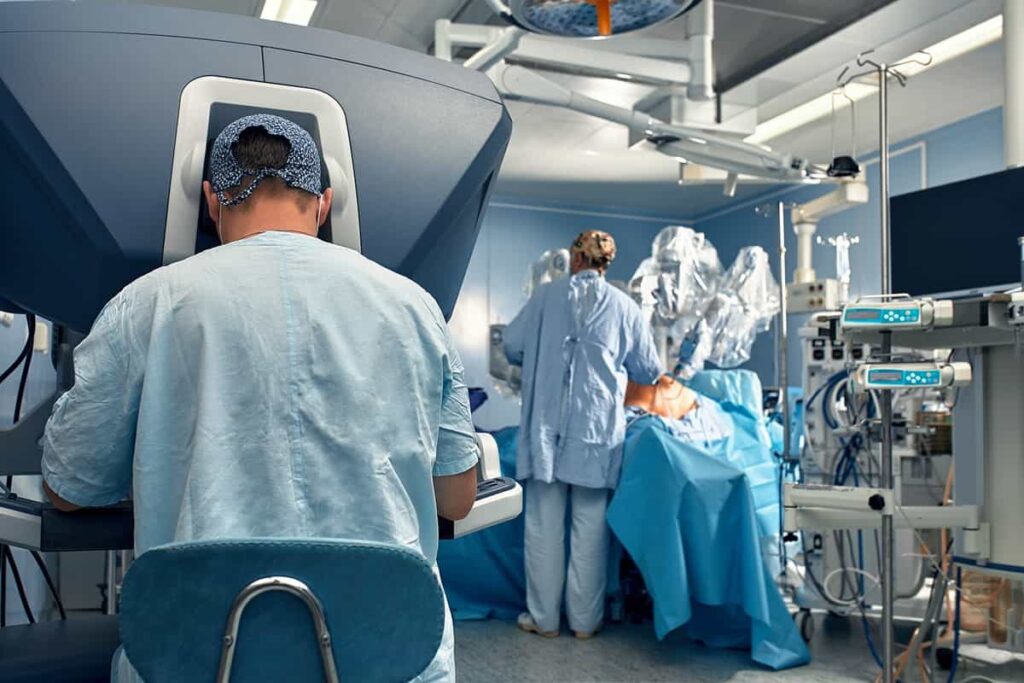Johnson & Johnson (JNJ) and Surgical Robotics
Table of contents
Table of contents

If you’re unfortunate enough to end up working in some unfulfilling finance role, you’ll spend the majority of your time trying to elbow your way to the front of the pack for a promotion. Then, when you finally do get that promotion, you get to listen to all your coworkers whinge about why they didn’t get promoted instead of you while plastering platitudes on LinkedIn like “well deserved.” You will also become familiar with another side effect of working in this field.
Mention you work in finance, and people will inevitably ask if you have any “stock tips.” It’s the same way that pilots probably get asked the “have you had any close calls” question, or police officers get the “have you ever shot someone” question. These are questions that the person being asked doesn’t really want to answer. In the case of the finance person though, they’re afforded an opportunity to dispense some advice which can help someone. That’s why we always answer by telling people to check out Dividend Growth Investing (DGI) stocks like Johnson & Johnson (JNJ).
Johnson & Johnson (JNJ)
If you’re a DGI investor, one stock you’re probably familiar with is Johnson & Johnson because they have not only paid a dividend but increased it for 56 years in a row. That sort of consistency – especially in the somewhat volatile healthcare industry – is quite remarkable. We love watching those dividend checks roll in, and have taken a “set it and forget it” approach to our investment. However, we do like to check in now and then, and decided to do so when we saw that JNJ acquired a surgical robot company we’ve talked about before – Auris Health – in what CB Insights has described as “the largest robotics M&A ever, ahead of Amazon’s 2012 purchase of robotic-fulfillment company Kiva.”
JNJ and Auris
When we last looked at Auris, they had taken in just over $733 million in funding to develop a robotic endoscope called Monarch that is controlled using a video game-like controller. (An endoscopy is a procedure that allows surgeons to access a patient’s body through small incisions or natural openings.) Around March of 2018, the device received regulatory approval, and in December of 2018, the company took in their last funding round – a $220 million Series E – to fund growth and help them sell the $500,000 Monarch devices directly to hospitals. The first target for the technology is lung cancer, and JNJ must have liked what they saw.
Just days ago, JNJ announced an agreement to acquire Auris Health for $3.4 billion in cash, along with additional contingent payments of up to $2.35 billion. While this may be the largest robotics M&A deal ever, it’s small potatoes for JNJ, a $365 billion company with 2017 revenues of more than $81 billion. Still, it’s useful to try and understand how this acquisition fits into JNJ’s overall strategy.
Last month, JNJ released their 2018 results in which we can see where they might place their new acquisition. Looks like Auris falls under the “medical devices” segment which accounted for one-third of total revenues for 2018.

(This is a highly diversified collection of businesses, not only by function but by geography, with just under half of all revenues coming from outside the United States.) Under the medical devices segment, the company further defines the category by breaking it down into further areas. One of these sub-segments is “Surgery” which accounts for 36.7% of medical device revenues or just around 12% of total revenues. Still, they break this down even further with the below sub-sub-categories:

If you had to guess which segment Auris Health falls under, it would seem that “Specialty” might be the one. This matters because it will be useful to track the segment’s growth in future earnings reports as a result of this acquisition. Of course, the company is not saying which segment the acquisition falls under, so let’s look at what they are saying about the acquisition.
JNJ and Surgical Robotics
The press release is the usual sort of output you’d expect. Hastily put together by some overpaid marketing & communications drone, it was then passed on to the division VP for a quick blessing before being quickly disseminated out across all the newswires so everyone could get back to making plans for Valentine’s Day. One notable thing it says is that co-founder and CEO of Auris Health, Frederic Moll, will be joining JNJ, and hopefully he stays there instead of pursuing yet another entrepreneurial venture. Maybe he’s looking for some stability after an extremely successful entrepreneurial run that included co-founding the most successful surgical robotics company yet, Intuitive Surgical (ISRG).
The press release also says that “this move is also complementary to the acquisition of Orthotaxy’s robotic technology for orthopaedics and the continued development of the Verb Surgical Platform, through a strategic partnership with Verily.” Orthotaxy was a French developer of “software-enabled surgery technologies, including a differentiated robotic-assisted surgery solution” for total and partial knee replacements, and was acquired by JNJ in February of 2018 for an undisclosed sum. Verb Surgical is one of Google’s moonshot ventures, and represents a partnership between Google and JNJ that’s roughly described as follows:

About a month ago, Verb Surgical’s CEO hit the road after three years of working at the startup without a named replacement. That’s not the best look. An article by Forbes which discusses that event states that Verb Surgical had their first “digital surgical prototype” demonstration in early 2017 “in front of Google co-founder Sergey Brin and J&J’s CEO Alex Gorsky.” Looks like they now have at least one suitable candidate to run Verb Surgical, and maybe JNJ can use this as an opportunity to take control over the whole thing so Google can get back to focusing on “not being evil.”
In perusing the 2018 earnings deck, we see that JNJ lists growth catalysts for their medical devices segment that include “launching meaningful new products” and “the progression of digital surgery platforms.” With $16 billion in cash on their balance sheet as of their last filing, and with Frederic Moll on board to steer their surgical robotics ship, maybe this latest acquisition is only the beginning of JNJ’s foray into surgical robotics.
Conclusion
Medtronic (MDT) is another healthcare DGI stock we hold. They’ve increased dividends for 41 years straight, and also decided to get into the high-growth area of surgical robotics with their acquisition of Mazor Robotics last year. To put into perspective just how fast surgical robotic applications can grow, we can look at Intuitive Surgical as an example. This company managed to increase revenues from 370 million to $3.7 billion in only twelve years’ time representing a Compound Annual Growth Rate (CAGR) of around 18.7%. Of course, these are revenues, not profits, but JNJ has plenty of experience acquiring companies and knows how to create “synergies” (“1 + 1 = 3” situations resulting from successful acquisitions) that give them more bang for their buck.
As many successful DGI companies do, JNJ manages their company as a portfolio of businesses. This enables them to move into high-growth areas and out of low-growth areas in response to environmental changes. In 2018, they divested six business areas that were underperforming. This allows the company to keep increasing those quarterly dividend checks, something they’ve been doing years before people had even heard of Star Trek or the Ford Mustang. Companies like JNJ are generally low-risk investments, unless of course they decide to start playing oppression bingo with employees instead of objectively rewarding competence, or engaging in politics instead of focusing on their portfolio of healthcare businesses. With a 56-year track record of past performance, it seems likely they’ll keep those dividends rising for years to come.
Sign up to our newsletter to get more of our great research delivered straight to your inbox!
Nanalyze Weekly includes useful insights written by our team of underpaid MBAs, research on new disruptive technology stocks flying under the radar, and summaries of our recent research. Always 100% free.














